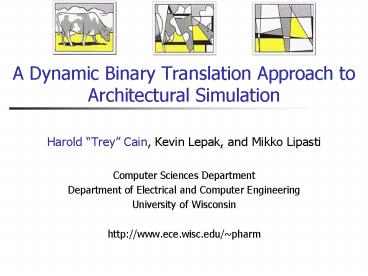A Dynamic Binary Translation Approach to Architectural Simulation - PowerPoint PPT Presentation
Title:
A Dynamic Binary Translation Approach to Architectural Simulation
Description:
A Dynamic Binary Translation Approach to Architectural Simulation Harold Trey Cain, Kevin Lepak, and Mikko Lipasti Computer Sciences Department – PowerPoint PPT presentation
Number of Views:111
Avg rating:3.0/5.0
Title: A Dynamic Binary Translation Approach to Architectural Simulation
1
A Dynamic Binary Translation Approach to
Architectural Simulation
- Harold Trey Cain, Kevin Lepak, and Mikko
Lipasti - Computer Sciences Department
- Department of Electrical and Computer Engineering
- University of Wisconsin
- http//www.ece.wisc.edu/pharm
2
Introduction
- Developing execution-driven PowerPC architectural
simulator, using existing out-of-order simulator
- SimpleScalar. - We would like to remain compatible with other
versions of SimpleScalar. - Perform dynamic binary translation from PowerPC
to SimpleScalars Portable Instruction Set
Architecture (PISA). - Translation occurs in extra pipeline stage
between fetch and decode. - similar to x86 instruction cracking from CISC
instructions to RISC-like m-ops.
3
Motivations
- We change a minimum of the original SimpleScalar
code. - We save development time.
- We can use the translator to study new
microarchitectural optimizations enabled by CISC
to RISC translation.
4
Outline
- Architectural Simulation SimpleScalar
- Implications of using translation in a simulator
- Implementation
- State Mapping PowerPC-gtPISA
- Complications Memory Operations
- Solution Speculative Decode
- Translation Efficiency
5
Architectural Simulation
- Hardware is expensive!
- Reasoning about complex systems using analytic
models alone is difficult. - Using simulation, we can test new architectural
ideas without building hardware. - Rapid growth in computer performance has enabled
increasingly detailed simulators. - SimOS can boot commercial operating systems.
6
SimpleScalar
- Execution-driven simulator models the internals
of out-of-order microprocessor - Implements the Portable Instruction Set
Architecture (PISA), a MIPS derivative - Many different versions in existence
- More than ¼ of PACT 2000 papers use SimpleScalar.
- We hope to leverage this significant body of
work.
7
Why do binary translation?
- Another alternative is to directly modify
SimpleScalar - It already includes hooks for supporting other
architectures e.g. Alpha - However, PowerPC ISA does not easily map to
SimpleScalars machine.def architecture
specification format - For instance, SimpleScalar assumes an instruction
will change at most two operands - Some PowerPC instructions write up to 32 output
registers
8
Implications
- We have different constraints than traditional
binary translators - Primary goal to accurately model the internals
of an out-of-order microprocessor - For some instructions, the overhead of performing
binary translation affects simulation accuracy - If accuracy is negatively affected by translation
overhead, we have the luxury of a flexible target
architecture.
9
Notable Differences PowerPC vs. PISA
PowerPC PISA
32 bit Instructions 64 bit Instructions
Result of compares stored in special CR Result of compares stored in GPRs
Allows unaligned memory references Disallows unaligned memory references
Single instructions may modify up to 32 registers All register-writing instructions modify at most two registers
Contains supervisor level state and instructions All system calls proxied by SimpleScalar
10
Outline
- Architectural Simulation SimpleScalar
- Implications of using translation in a simulator
- Implementation
- State Mapping PowerPC-gtPISA
- Complications Memory Operations
- Solution Speculative Decode
- Translation Efficiency
11
SimpleScalar Pipeline
12
SimpleScalar Pipeline
13
SimpleScalar Pipeline
- Fetch stage minimally changed
- Pipeline stages from decode to commit unchanged
14
PowerPC-gtPISA State Mapping
PowerPC Registers SimpleScalar Registers
32 GPRs 32 GPRs
Link Reg. 1 GPR
Count Reg. 1 GPR
Condition Reg. 8 GPRs
Exception Reg. 4 GPRs
FP Status Control Reg 1 GPR
32 Floating Point Regs 64 Floating Point Regs
15
Control Transfer Instructions
- Control instructions in PowerPC are powerful
(e.g. bdnztlrl) or slightly more general (e.g.
bclr) - To translate, we need to allow multiple branches
in the translation of a single PowerPC
instruction - Need to insure that SimpleScalar branch
predictors/etc. are not impacted substantially by
two control instructions at the same PC - Also optimize common cases
- Need to assure superblock structures to eliminate
instruction address space issues
16
Control Transfer--Continued
PowerPC
SimpleScalar/PISA
. . .
PC beq r0, rscratch, PC4
PC jr lr
F
PC bclr cr2
PC4 . . .
T
Protection Branch
PC beq r0, rscratch, PC4
PPC Condition
PC jr lr
PC4 . . .
X Squash at Execute
- Only one control transfer instruction appears
at PC (PowerPC branch location) - Translations maintain superblock properties
17
Memory Operations
- Two issues
- Alignment PowerPC supports unaligned memory
access, PISA does not. - Most memory operations use registeroffset
addressing mode - PowerPC lswx and stswx string instructions
- Read/Write a variable number of bytes from
memory, length specified by register - Cannot perform translation until all operands
have been written - Naïve implementation would stall pipeline,
affecting performance
18
Speculative Decode
- Optimistically translate instructions into a
simpler sequence by exploiting a runtime
attribute - Translate all memory operations assuming natural
alignment - Translate all lswx and stswx instructions by
predicting their size with a history-based
predictor - If speculation is incorrect, roll back pipeline
19
Alignment Prediction
Application unaligned references
DB2 TPC-B .00
Java TPC-W .34
compress .00
gcc .01
go .00
ijpeg .02
li .00
m88ksim .00
perl .00
vortex .00
20
Length Prediction
Using 256 entry last-value predictor
21
Outline
- Architectural Simulation SimpleScalar
- Implications of using translation in a simulator
- Implementation
- State Mapping PowerPC-gtPISA
- Complications Memory Operations
- Solution Speculative Decode
- Translation Efficiency
22
Instruction Expansion
Dynamic Instruction Growth 86 and 35
respectively
Memory Instr Growth lt 1
23
Future Work
- Simulation Infrastructure
- Running more applications!
- Integrating Translator into a Multiprocessor
version of SimpleScalar (SimpleMP, Ravi Rajwar) - Integrating Translator/SimpleMP into SimOS-PPC
full system simulator - Speculative Decode
24
Questions?































